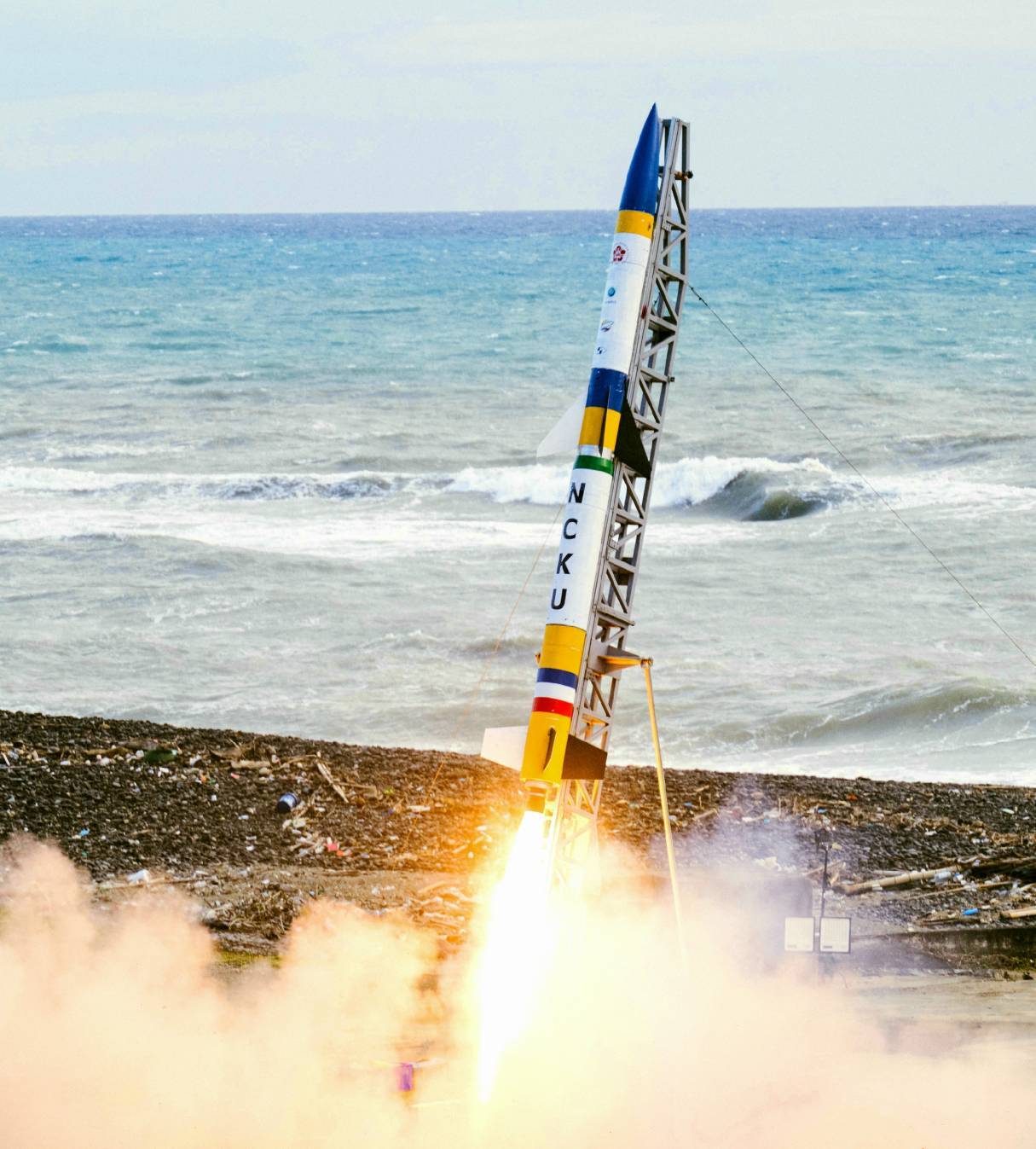NCKU's two-stage hybrid rocket was successfully launched at the Syuhai Scientific Research Rocket Launch Site
Content and image credit to National Science and Technology Council.

NCKU successfully launched a two-stage hybrid rocket on November 8 at Pingtung County, Taiwan
At the short-term scientific research rocket launch site of NSTC in Syuhai Village, Mudan Township, Pingtung County, NCKU successfully launched a two-stage hybrid rocket of 1,500 kg-class thrust and 300 kg-class thrust at 6:47 am today (11/8). NSTC affirmed the efforts of the NCKU team, and also expressed its gratitude to the Syuhai tribe of the MudanTownship Public Office in Pingtung County for their support and assistance.
The two-stage hybrid rocket was developed and produced by a large multidisciplinary hybrid rocket team led by Yei-Chin Chao, chair professor of the Department of Aeronautics and Astronautics of NCKU, with a total length of 6.2 meters, a maximum diameter of 34 centimeters, and a weight of about 260 kilograms. The thrust classes are 1,500 kg in the first stage and 300 kg in the second stage. In this test flight, the first stage of the rocket was successfully separated after 13 seconds of burning, according to the mission flight plan, and the preliminary judgment of the second stage rocket seems also appropriately trigger the propulsion, but the propulsion duration and the final flight trajectory has to be investigated carefully by NCKU after the experiment. This is the first time that a Taiwanese academic unit has launched a two-stage hybrid rocket with 1,500 kg thrust and 300 kg thrust, and successfully completed the key technology test of aerodynamic saperation and high-altitude ignition.
The scientific research rocket was originally scheduled to be launched on August 1, but after the completion of the oxidant filling operation before launch, the NCKU team found that there was a carbon fiber stretching and peeling phenomenon at the assembly interface of the carbon fiber barrel tank, although there was no leakage in the high-pressure barrel tank body, but the flight test task needed to be reviewed with the highest safety standards, so it was decided to cancel the launch, and only reapplied after completing the reinforcement and passing the 60 bar (about 60 atmospheric pressure) water pressure test, and the launch was successful.

The team is led by Yei-Chin Chao, chair professor of the Department of Aeronautics and Astronautics of NCKU
Professor Yei-Chin Chao said that based on the 1,500-kilogram thrust hybrid rocket successfully launched in 2019, after three years of research and improvement, major breakthroughs have been made in engine development, component design and manufacturing, disjointed mechanism and assembly, and aerial ignition. Moreover, the key components and supporting instruments required for rocket flight, regardless of design, technology and manufacturing, are all from the hands of large teams and Chinese people, and 100% autonomous. In addition to verifying the thruster system, aerodynamic disconnection and high-altitude re-ignition technology of the two rockets, it is also expected to achieve the full tracking of the rocket's high dynamic trajectory through the communication telemetry avionics system and the high-dynamic GPS "INS/GNSS real-time trajectory tracking" system.
In addition, the rocket is also equipped with the scientific "Compact Scintillator Array Detector" (ComSAD) designed by Yi Yang, associate professor of the Department of Physics of NCKU, which is the first high-energy cosmic ray detector developed by Taiwan and can be used in sounding rockets and CubeSats to detect the energy and direction of cosmic rays. The sounding rocket mission is mainly to test the basic performance of ComSAD as the basis for future missions, hoping to complete scientific missions such as CubeSats Galaxy at a lower cost in the future.
The National Space Organization of NARLabs of NSTC, which is responsible for maintaining the short-term scientific research rocket launch site, pointed out that the two-stage hybrid rocket independently developed by NCKU has entered the practical stage of breaking through the important key of disconnection and high-altitude ignition. The 1,500 kg thrust class hybrid rocket can meet the design specifications and operate normally, which means that the NCKU team has indeed mastered the principle of thrust amplification, and this research and development result is not easy, and it is expected to carry scientific payloads and obtain more space data in the future.
NSTC said that with the development of the emerging global space industry, Taiwan should seize the opportunity, integrate the academical research circles and the industry, and actively invest in space-related niche industries. NSTC has set up a short-term scientific research rocket launch site in Syuhai to provide legal and safe facilities for space research teams. They will also continue to supervise the National Space Organization, which will soon be upgraded to an independent administrative institution, make proper use of this short-term scientific research rocket launch site, actively link the energy of Taiwan's industry, education and research circles, upgrade the level of space science and technology, cultivate key space science and technology talents, and lead Taiwan to seize the new blue ocean of space.
Click Num:
Share
